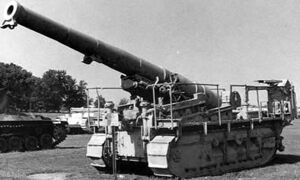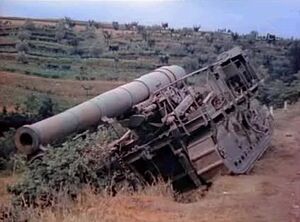Casúr TAM (SPG)
| Casúr de TAM 1923/Type 1923 'Casúr' Track Gun | |
|---|---|
 | |
| Type | Self-propelled artillery |
| Place of origin | Faneria |
| Service history | |
| In service | 1924-1968 |
| Used by | Faneria |
| Wars | |
| Production history | |
| Designer | Teilgcheárta de Armann Marlfaeld |
| Designed | 1923 |
| Produced | 1918-1919 |
| No. built | 17,430 total
|
| Variants |
|
| Specifications | |
| Mass | 65,300 lb (29,600 kg) |
| Barrel length | 6.57 m (21 ft 7 in) L/42.2 |
| Width | 2.54 m (8 ft 4 in) |
| Height | 7.775 m (25 ft 6 in) |
| Shell | 80.86 kg (200 lb) |
| Caliber | 8" (203.2mm) |
| Elevation |
|
| Traverse | 40° |
| Maximum firing range |
|
Main armament |
|
| Engine | 210 hp |
| Power/weight | 6.4 hp/ton |
| Maximum speed |
|
The Casúr (Aen. Hammer) was a tracked self-propelled gun platform designed by Teilgcheárta de Armann Marlfaeld (Marlfield Arms Foundry) in the 1920s for the Fhainnin Army. Shortly after the introduction of the design, TAM was bought by the government and integrated into the National Arms Foundry as TANF Marlfield, and mass production began in Marlfield, Cancale, and Luinndún in the late 1920s and early 1930s.
The third SPG design introduced into a world military and the first to be mass-produced, Hammers served as the fountational platform for heavy-caliber fire support for the National Army during the Second Great War and played a pivotal role in nearly every major land battle in the northern theater except mountain fighting, such as the Battle of Lark's Pass. The mobility and degree of fire provided by the vehicle proved a decisive factor in Fhainnin victories throughout the early war, and significantly affected strategic planning by Faneria's military leadership throughout the conflict. The Hammer's track system also directly inspired the tracks initially used on Fhainnin heavy tanks, which proved severely inadequate for large-scale, mobile tank combat such as the critical maneuver stages of the Battle of Culich.
Design and Production

Two variations of the basic chassis were designed; one gun carrige and a towing and munition tractor being expected per gun team, as the aim of the concept was to reduce the required trucking of ammunition associated with towed guns. The gun carriage was designed for a heavy 8" howitzer which was produced in Cancale primarily; however, other guns such as the Type 1930 6" Field Gun would be fitted to it by rear salvage centers when replacement 8" barrels were unavailable in practice. The tractor carriage could be hitched to the gun itself to increase traction and fractionally improve travel speed on roads, and many additional tractor variants were constructed as carriers for 6" towed gun ammunition, 10" ammunition for the heavy Type 1933 10" Field Gun, or bulk carriers for small arms, mortar, rocket, and other types of ammunition or conventional supplies when needed. In some cases, the gun carriage would be used to mount the longer naval variant of the 1930 6" gun, which was unsuitable for conventional carriages.
Service

Sets of Casúrs were first deployed to Army formations in the Spring of 1924, taking part in several army drills testing the efficacy of differing allocations of fire control. Ultimately, it was decided that 8" guns would be delegated to the division level, with most divisions recieving a six-gun battery and armored and motor divisions recieving four batteries. During reorganizations in 1930, this was devolved to brigade-level batteries, and the Army would field over four thousand sets of Hammers by the 1935 invasion of Fiannria, continuously increasing the number of 8" guns wherever possible. Production of the carriages slowed drastically from 1936-1942 to save metal for shells and replacement barrels, though at least half the number of carriages introduced into service were still in operation by the end of Faneria's role in the war in 1942 (though gun carriages in particular suffered roughly 36% higher casualty rates across the entire war, particularly falling prey to tactical air strikes in increasing regularity in 1941 and 1942). The use of so many heavy-caliber howitzers placed immense strain on Fhainnin logistics throughout the war even with the supposed advantages of a self-propelled artillery system, as well as increasing the requirements for fuel and parts past what could feasibly be managed; as a result, in many cases Fhainnin combat effectiveness at the operational level hinged on the ability to supply these guns. The level of doctrinal and experience-based reliance on the firepower provided by Hammers throughout the duration of the war often resulted in a major bias towards risk avoidance in Fhainnin commanding officers, paralyzing many units' ability to take initiative without significant preparation up to even the brigade and division level in the mid- and late war.
Postwar, the production of new vehicles and barrels was ceased, with the system remaining in service without a replacement until the 1960s. Casúrs have been sold to over a dozen nations since then, and Faneria maintains a stock of 170 carriages which are used as training systems before artillery crews are moved to modern guns. In 1994, the Army began to replace its training Casúrs with modern SPG systems, with most of the remaining exampled being retained by private collections, tank societies, cinema supply companies, foreign militaries, and museums.